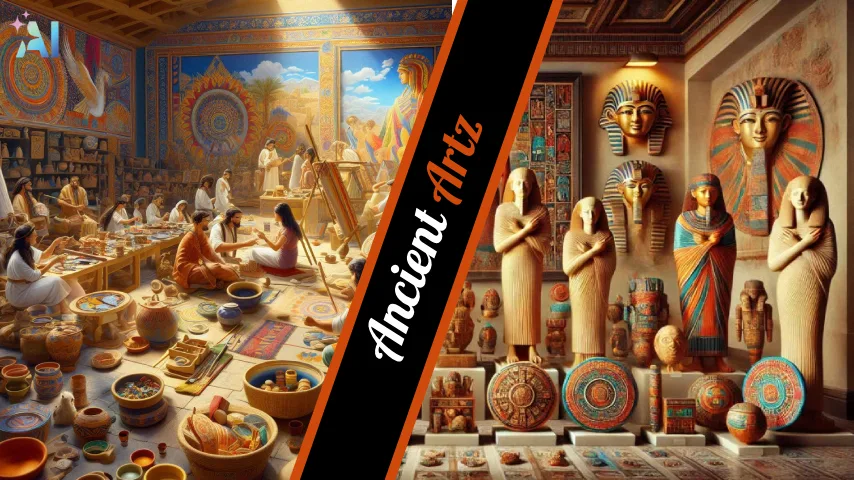Ancient artz is a fascinating window into the past, showcasing the creativity and ingenuity of our ancestors. It’s not just old stuff gathering dust in museums; it’s a vibrant testament to human expression that has shaped cultures across the globe. Let’s dive into this colorful world and explore why it still captivates us today!
What is Ancient Artz?
Ancient artz refers to artistic creations from civilizations that flourished thousands of years ago, spanning from prehistoric times to the early medieval period. It’s like a time capsule of human creativity, capturing the essence of long-gone societies through various forms of expression.
These artistic works aren’t just pretty to look at. They’re packed with meaning, reflecting the beliefs, values, and daily lives of people who walked the Earth long before us. From intricate pottery to majestic stone carvings, ancient artz offers a unique glimpse into the minds of our ancestors.
When Did Ancient Artz Begin?
You might be surprised to learn just how far back ancient artz goes. The earliest known examples date back to a mind-boggling 77,000 years ago! These weren’t grand sculptures or elaborate paintings, but rather simple carved ochre pieces found in Blombos Cave, South Africa.
Imagine that – tens of thousands of years ago, someone picked up a piece of ochre and started carving. It’s a humbling thought, isn’t it? This early art marks the beginning of a long and rich tradition of human creativity that continues to this day.
Types of Ancient Artz
Ancient artz isn’t just one thing – it’s a diverse collection of creative expressions. Here are some of the main types:
- Sculptures and statues: From the towering Colossi of Memnon in Egypt to the delicate figurines of the Indus Valley, sculptures were a popular form of ancient artz.
- Murals and frescoes: Think of the vibrant wall paintings in Egyptian tombs or the detailed frescoes of Pompeii.
- Pottery and ceramics: Ancient civilizations created beautiful and functional pottery, often decorated with intricate designs.
- Jewelry and metalwork: From golden Egyptian scarabs to intricate Celtic torcs, jewelry was both decorative and symbolic.
- Architectural marvels: The pyramids, the Parthenon, the Great Wall of China – these aren’t just buildings, they’re works of art in their own right.
Each of these forms tells its own story, giving us insights into the skills, beliefs, and daily lives of ancient peoples.
Which Materials Were Used?
Ancient artists were incredibly resourceful, using whatever materials were available to them. Here’s what they typically worked with:
- Stone: From marble sculptures to limestone reliefs, stone was a popular and durable medium.
- Clay: Used for pottery, figurines, and even as a writing surface for cuneiform scripts.
- Metal: Gold, silver, bronze, and copper were used for jewelry, statues, and decorative objects.
- Wood: Though less durable than stone or metal, wood was used for everything from statues to sarcophagi.
- Natural pigments: These were used to add color to paintings, pottery, and even sculptures.
The choice of material often depended on what was locally available and the purpose of the artwork. For instance, precious metals might be reserved for religious objects or royal commissions.
How Was Ancient Artz Created?
Techniques
Ancient artists were incredibly skilled, using a variety of techniques to bring their visions to life:
- Carving: This was used for stone sculptures and reliefs. Imagine chipping away at a block of marble to reveal a lifelike statue!
- Casting: Metal objects were often created by pouring molten metal into molds.
- Painting: From cave walls to pottery, painting was a widespread technique.
- Building: Architecture is a form of art too, and ancient builders created stunning structures that have stood the test of time.
Tools
To create their masterpieces, ancient artists used a variety of tools:
- Chisels: Essential for carving stone and wood.
- Molds: Used in metalworking to create complex shapes.
- Brushes: Made from animal hair or plant fibers, these were used for painting.
- Pottery wheels: These helped create symmetrical pottery shapes.
While these tools might seem primitive compared to what we have today, in the hands of skilled artisans, they produced incredible works of art.
What Were the Purposes of Ancient Artz?
Ancient artz wasn’t just about making things look pretty. It served several important purposes:
- Spiritual significance: Many artworks were created for religious or spiritual reasons. Think of the intricate carvings in Hindu temples or the symbolic paintings in Egyptian tombs.
- Historical documentation: Before writing became widespread, art was a way to record important events and stories.
- Symbols of power: Rulers often commissioned grand artworks to showcase their authority. The massive statues of pharaohs are a perfect example.
- Everyday expression: Not all ancient artz was grand or monumental. Many pieces, like Greek vases or Roman mosaics, depicted scenes of daily life.
Ancient Artz Timeline
To really understand ancient artz, it helps to look at how it developed over time. Here’s a quick timeline:
| Period | Time Range | Key Features |
|---|---|---|
| Prehistoric Art | 30,000 BCE – 3000 BCE | Cave paintings, carvings, megalithic structures |
| Mesopotamian Art | 3000 BCE – 500 BCE | Ziggurats, statues, cylinder seals |
| Egyptian Art | 3100 BCE – 30 BCE | Pyramids, tomb paintings, hieroglyphics |
| Greek and Roman Art | 1200 BCE – 500 CE | Classical sculptures, pottery, monumental architecture |
| Asian Art | 2000 BCE – 500 CE | Buddhist sculptures, Chinese jade carvings, Indian temple art |
This timeline shows how art evolved from simple cave paintings to complex architectural wonders over thousands of years.
Famous Examples of Ancient Artz
Some ancient artworks have become iconic, recognized around the world. Here are a few you might have heard of:
- The Great Sphinx (Egypt): This massive limestone statue with a lion’s body and a human head has guarded the Giza plateau for thousands of years.
- The Rosetta Stone (Egypt): More than just a pretty carving, this stone was key to deciphering Egyptian hieroglyphs.
- The Discus Thrower (Greece): This famous statue captures the beauty and athleticism prized in ancient Greek culture.
- The Great Wall of China: While it’s primarily a defensive structure, the Great Wall is also an incredible feat of design and engineering.
- The Nazca Lines (Peru): These massive geoglyphs, only fully visible from the air, continue to mystify researchers today.
Each of these works tells us something unique about the culture that created it.
How Was Ancient Artz Preserved?
It’s pretty amazing that we can still see artworks created thousands of years ago. So how did they survive? There are two main ways:
- Natural conditions: Some artworks were preserved by accident. The dry climate of Egypt, for example, helped preserve many ancient artifacts. In other cases, volcanic eruptions (like at Pompeii) or burial in tombs protected artworks from decay.
- Modern conservation: Today, we use advanced techniques to preserve and restore ancient artworks. This includes controlling temperature and humidity in museums, using special chemicals to prevent decay, and even using lasers for cleaning delicate surfaces.
Thanks to these methods, we can still enjoy and learn from artworks created by our ancestors thousands of years ago.
Ancient Artz VS. Modern Art
While ancient artz and modern art might seem worlds apart, they’re more connected than you might think. Let’s compare them:
Ancient Artz
- Created tangible, physical products
- Used a wide range of materials, from stone to precious metals
- Often had religious or political significance
- Techniques and styles were passed down through generations
Modern Digital Art
- Can exist purely in digital form
- Uses new technologies like computer graphics and virtual reality
- Often explores abstract concepts or personal expression
- Constantly evolving with new technologies and techniques
Despite these differences, both ancient and modern art share the same core purpose: expressing human creativity and communicating ideas.
Conclusion
Ancient artz is more than just old relics in museums. It’s a vibrant testament to human creativity that has shaped cultures across the globe. From the earliest cave paintings to grand architectural wonders, these artworks offer us a unique window into the past.
They show us what mattered to our ancestors – their beliefs, their daily lives, their hopes and fears. By studying ancient artz, we can better understand our own cultural roots and the long journey of human creativity.
So the next time you see an ancient artwork, take a moment to really look at it. Think about the person who created it thousands of years ago. What were they trying to say? What can we learn from them? You might be surprised at how much these ancient artists still have to teach us today.





